The Early Paleocene Ranikot Formation, Sulaiman Fold-Thrust Belt, Pakistan: Detrital Zircon Provenance and Tectonic Implications
Abstract
1. Introduction
2. Geological Setting and Stratigraphy
3. Analytical Methods
3.1. Petrography
3.2. U-Pb Geochronology
4. Results
4.1. Sandstone Petrography
4.2. U-Pb Geochronology of Detrital Zircon
5. Discussion
5.1. Source Terranes Detrital Ages
5.2. Provenance of the Ranikot Formation
5.3. Tectonic Implications
6. Conclusions
Supplementary Materials
Author Contributions
Funding
Data Availability Statement
Acknowledgments
Conflicts of Interest
References
- Ding, L.; Kapp, P.; Wan, X. Paleocene-Eocene record of ophiolite obduction and initial India-Asia collision, south central Tibet. Tectonics 2005, 24, TC3001. [Google Scholar] [CrossRef]
- Garzanti, E.; Hu, X. Latest Cretaceous Himalayan tectonics: Obduction, collision or Deccan-related uplift? Gondwana Res. 2015, 28, 165–178. [Google Scholar] [CrossRef]
- Searle, M.; Treloar, P. Was Late Cretaceous–Paleocene obduction of ophiolite complexes the primary cause of crustal thickening and regional metamorphism in the Pakistan Himalaya? Geol. Soc. Lond. Spec. Publ. 2010, 338, 345–359. [Google Scholar] [CrossRef]
- Beck, R.A.; Burbank, D.W.; Sercombe, W.J.; Riley, G.W.; Barndt, J.K.; Berry, J.R.; Afzal, J.; Khan, A.M.; Jurgen, H.; Metje, J. Stratigraphic evidence for an early collision between northwest India and Asia. Nature 1995, 373, 55–58. [Google Scholar] [CrossRef]
- Awais, M.; Qasim, M.; Tanoli, J.I.; Ding, L.; Sattar, M.; Baig, M.S.; Pervaiz, S. Detrital Zircon Provenance of the Cenozoic Sequence, Kotli, Northwestern Himalaya, Pakistan; Implications for India–Asia Collision. Minerals 2021, 11, 1399. [Google Scholar] [CrossRef]
- Ding, L.; Qasim, M.; Jadoon, I.A.; Khan, M.A.; Xu, Q.; Cai, F.; Wang, H.; Baral, U.; Yue, Y. The India–Asia collision in north Pakistan: Insight from the U–Pb detrital zircon provenance of Cenozoic foreland basin. Earth Planet. Sci. Lett. 2016, 455, 49–61. [Google Scholar] [CrossRef]
- Qasim, M.; Ding, L.; Khan, M.A.; Jadoon, I.A.; Haneef, M.; Baral, U.; Cai, F.; Wang, H.; Yue, Y. Tectonic implications of detrital zircon ages from lesser Himalayan Mesozoic-Cenozoic strata, Pakistan. Geochem. Geophys. Geosystems 2018, 19, 1636–1659. [Google Scholar] [CrossRef]
- DeCelles, P.; Gehrels, G.; Najman, Y.; Martin, A.; Carter, A.; Garzanti, E. Detrital geochronology and geochemistry of Cretaceous–Early Miocene strata of Nepal: Implications for timing and diachroneity of initial Himalayan orogenesis. Earth Planet. Sci. Lett. 2004, 227, 313–330. [Google Scholar] [CrossRef]
- DeCelles, P.; Kapp, P.; Gehrels, G.; Ding, L. Paleocene-Eocene foreland basin evolution in the Himalaya of southern Tibet and Nepal: Implications for the age of initial India-Asia collision. Tectonics 2014, 33, 824–849. [Google Scholar] [CrossRef]
- Najman, Y. The detrital record of orogenesis: A review of approaches and techniques used in the Himalayan sedimentary basins. Earth-Sci. Rev. 2006, 74, 1–72. [Google Scholar] [CrossRef]
- Cai, F.; Ding, L.; Yue, Y. Provenance analysis of upper Cretaceous strata in the Tethys Himalaya, southern Tibet: Implications for timing of India–Asia collision. Earth Planet. Sci. Lett. 2011, 305, 195–206. [Google Scholar] [CrossRef]
- Chen, Y.; Ding, L.; Li, Z.; Laskowski, A.K.; Li, J.; Baral, U.; Qasim, M.; Yue, Y. Provenance analysis of Cretaceous peripheral foreland basin in central Tibet: Implications to precise timing on the initial Lhasa-Qiangtang collision. Tectonophysics 2020, 775, 228311. [Google Scholar] [CrossRef]
- Clift, P.D.; Carter, A.; Jonell, T.N. U–Pb dating of detrital zircon grains in the Paleocene Stumpata Formation, Tethyan Himalaya, Zanskar, India. J. Asian Earth Sci. 2014, 82, 80–89. [Google Scholar] [CrossRef]
- Gehrels, G.; Kapp, P.; DeCelles, P.; Pullen, A.; Blakey, R.; Weislogel, A.; Ding, L.; Guynn, J.; Martin, A.; McQuarrie, N. Detrital zircon geochronology of pre-Tertiary strata in the Tibetan-Himalayan orogen. Tectonics 2011, 30, TC5016. [Google Scholar] [CrossRef]
- Hu, X.; Garzanti, E.; An, W.; Hu, X.-F. Provenance and drainage system of the Early Cretaceous volcanic detritus in the Himalaya as constrained by detrital zircon geochronology. J. Palaeogeogr. 2015, 4, 85–98. [Google Scholar] [CrossRef]
- Hu, X.; Garzanti, E.; Moore, T.; Raffi, I. Direct stratigraphic dating of India-Asia collision onset at the Selandian (middle Paleocene, 59 ± 1 Ma). Geology 2015, 43, 859–862. [Google Scholar] [CrossRef]
- Hu, X.; Wang, J.; An, W.; Garzanti, E.; Li, J. Constraining the timing of the India-Asia continental collision by the sedimentary record. Sci. China Earth Sci. 2017, 60, 603–625. [Google Scholar] [CrossRef]
- Qasim, M.; Tabassum, K.; Ding, L.; Tanoli, J.I.; Awais, M.; Baral, U. Provenance of the Late Cretaceous Pab Formation, Sulaiman fold-thrust belt, Pakistan: Insight from the detrital zircon U–Pb geochronology and sandstone petrography. Geol. J. 2022, 57, 4439–4450. [Google Scholar] [CrossRef]
- Qasim, M.; Tanoli, J.I.; Ahmad, L.; Ding, L.; Rehman, Q.U.; Umber, U. First U-Pb Detrital Zircon Ages from Kamlial Formation (Kashmir, Pakistan): Tectonic Implications for Himalayan Exhumation. Minerals 2022, 12, 298. [Google Scholar] [CrossRef]
- Abbasi, I.A.; Friend, P.F. Uplift and evolution of the Himalayan orogenic belts, as recorded in the foredeep molasse sediments. Z. Geomorphol. NF Suppl. 1989, 76, 75–88. [Google Scholar]
- Abbasi, I.A.; Khan, M.A. Heavy mineral analysis of the molasse sediments, Trans Indus Ranges, Kohat, Pakistan. J. Himal. Earth Sci. 1990, 23, 215–229. [Google Scholar]
- Ahmed, F.; Kasi, A.K.; Mohibullah, M.; Manan, R.A. Petrology and Geochemistry of the Late Cretaceous Pab Formation, Western Sulaiman fold-thrust-belt, Pakistan: Implications for Provenance and Paleo-weathering. J. Mt. Area Res. 2021, 6, 45–62. [Google Scholar] [CrossRef]
- Garzanti, E. Stratigraphy and sedimentary history of the Nepal Tethys Himalaya passive margin. J. Asian Earth Sci. 1999, 17, 805–827. [Google Scholar] [CrossRef]
- Garzanti, E.; Baud, A.; Mascle, G. Sedimentary record of the northward flight of India and its collision with Eurasia (Ladakh Himalaya, India). Geodin. Acta 1987, 1, 297–312. [Google Scholar] [CrossRef]
- Umar, M.; Friis, H.; Khan, A.S.; Kelling, G.; Kassi, A.M.; Sabir, M.A.; Farooq, M. Sediment composition and provenance of the Pab formation, Kirthar fold belt, Pakistan: Signatures of hot spot volcanism, source area weathering, and paleogeography on the western passive margin of the Indian plate during the Late Cretaceous. Arab. J. Sci. Eng. 2014, 39, 311–324. [Google Scholar] [CrossRef]
- Nazeer, A.; Solangi, S.H.; Brohi, I.A.; Usmani, P.; Napar, L.D.; Jahangir, M.; Hameed, S.; Ali, S.M. Hydrocarbon Potential of Zinda Pir Anticline, Eastern Sulaiman Fold Belt, Middle Indus Basin, Pakistan. Pak. J. Hydrocarb. Res. 2012, 22, 13. [Google Scholar]
- Jadoon, I.A.; Ding, L.; Nazir, J.; Idrees, M.; Saif-ur-Rehman, K.J. Structural interpretation of frontal folds and hydrocarbon exploration, western sulaiman fold belt, Pakistan. Mar. Pet. Geol. 2020, 117, 104380. [Google Scholar] [CrossRef]
- Jadoon, I.A.; Lawrence, R.D.; Lillie, R.J. Seismic data, geometry, evolution, and shortening in the active Sulaiman fold-and-thrust belt of Pakistan, southwest of the Himalayas. AAPG Bull. 1994, 78, 758–774. [Google Scholar]
- Jadoon, I.A.; Lawrence, R.D.; Lillie, R.J. Balanced and retrodeformed geological cross-section from the frontal Sulaiman Lobe, Pakistan: Duplex development in thick strata along the western margin of the Indian Plate. In Thrust Tectonics; McClay, K.R., Ed.; Springer: Dordrecht, The Netherlands, 1992; pp. 343–356. [Google Scholar]
- Jadoon, I.A.; Khurshid, A. Gravity and tectonic model across the Sulaiman fold belt and the Chaman fault zone in western Pakistan and eastern Afghanistan. Tectonophysics 1996, 254, 89–109. [Google Scholar] [CrossRef]
- Shah, S.I. Stratigraphy of Pakistan; Government of Pakistan Ministry of Petroleum & Natural Resorces Geological Survey of Pakistan: Islamabad, Pakistan, 2009.
- Dickinson, W.R. Interpreting Provenance Relations from Detrital Modes of Sandstones, Provenance of Arenites; Springer: Dordrecht, The Netherlands, 1985; pp. 333–361. [Google Scholar]
- Wiedenbeck, M.; Alle, P.; Corfu, F.; Griffin, W.L.; Meier, M.; Oberli, F.; Quadt, A.V.; Roddick, J.C.; Spiegel, W. Three natural zircon standards for U-Th-Pb, Lu-Hf, trace element and REE analyses. Geostand. Newsl. 1995, 19, 1–23. [Google Scholar] [CrossRef]
- Ludwig, K. Isoplot/Ex 3. In A Geochronological Toolkit for Microsoft Excel; Special publication; Berkeley Geochronology Center: Berkeley, CA, USA, 2003. [Google Scholar]
- Corfu, F.; Hanchar, J.M.; Hoskin, P.W.; Kinny, P. Atlas of zircon textures. Rev. Mineral. Geochem. 2003, 53, 469–500. [Google Scholar] [CrossRef]
- Rubatto, D. Zircon trace element geochemistry: Partitioning with garnet and the link between U–Pb ages and metamorphism. Chem. Geol. 2002, 184, 123–138. [Google Scholar] [CrossRef]
- Fornelli, A.; Festa, V.; Micheletti, F.; Spiess, R.; Tursi, F. Building an Orogen: Review of U-Pb Zircon Ages from the Calabria–Peloritani Terrane to Constrain the Timing of the Southern Variscan Belt. Minerals 2020, 10, 944. [Google Scholar] [CrossRef]
- Aikman, A.B.; Harrison, T.M.; Lin, D. Evidence for Early (>44 Ma) Himalayan Crustal Thickening, Tethyan Himalaya, southeastern Tibet. Earth Planet. Sci. Lett. 2008, 274, 14–23. [Google Scholar] [CrossRef]
- Myrow, P.; Hughes, N.; Paulsen, T.; Williams, I.; Parcha, S.; Thompson, K.; Bowring, S.; Peng, S.-C.; Ahluwalia, A. Integrated tectonostratigraphic analysis of the Himalaya and implications for its tectonic reconstruction. Earth Planet. Sci. Lett. 2003, 212, 433–441. [Google Scholar] [CrossRef]
- Myrow, P.; Hughes, N.C.; Searle, M.P.; Fanning, C.; Peng, S.-C.; Parcha, S. Stratigraphic correlation of Cambrian–Ordovician deposits along the Himalaya: Implications for the age and nature of rocks in the Mount Everest region. Geol. Soc. Am. Bull. 2009, 121, 323–332. [Google Scholar] [CrossRef]
- Cawood, P.A.; Johnson, M.R.; Nemchin, A.A. Early Palaeozoic orogenesis along the Indian margin of Gondwana: Tectonic response to Gondwana assembly. Earth Planet. Sci. Lett. 2007, 255, 70–84. [Google Scholar] [CrossRef]
- Fraser, J.E.; Searle, M.P.; Parrish, R.R.; Noble, S.R. Chronology of deformation, metamorphism, and magmatism in the southern Karakoram Mountains. Geol. Soc. Am. Bull. 2001, 113, 1443–1455. [Google Scholar] [CrossRef]
- Heuberger, S.; Schaltegger, U.; Burg, J.-P.; Villa, I.M.; Frank, M.; Dawood, H.; Hussain, S.; Zanchi, A. Age and isotopic constraints on magmatism along the Karakoram-Kohistan Suture Zone, NW Pakistan: Evidence for subduction and continued convergence after India-Asia collision. Swiss J. Geosci. 2007, 100, 85–107. [Google Scholar] [CrossRef]
- Jain, A.K.; Singh, S. Tectonics of the southern Asian Plate margin along the Karakoram Shear Zone: Constraints from field observations and U–Pb SHRIMP ages. Tectonophysics 2008, 451, 186–205. [Google Scholar] [CrossRef]
- Ravikant, V.; Wu, F.-Y.; Ji, W.-Q. Zircon U–Pb and Hf isotopic constraints on petrogenesis of the Cretaceous–Tertiary granites in eastern Karakoram and Ladakh, India. Lithos 2009, 110, 153–166. [Google Scholar] [CrossRef]
- Ravikant, V.; Wu, F.-Y.; Ji, W.-Q. U–Pb age and Hf isotopic constraints of detrital zircons from the Himalayan foreland Subathu sub-basin on the Tertiary palaeogeography of the Himalaya. Earth Planet. Sci. Lett. 2011, 304, 356–368. [Google Scholar] [CrossRef]
- Ji, W.-Q.; Wu, F.-Y.; Chung, S.-L.; Li, J.-X.; Liu, C.-Z. Zircon U–Pb geochronology and Hf isotopic constraints on petrogenesis of the Gangdese batholith, southern Tibet. Chem. Geol. 2009, 262, 229–245. [Google Scholar] [CrossRef]
- Bouilhol, P.; Jagoutz, O.; Hanchar, J.M.; Dudas, F.O. Dating the India–Eurasia collision through arc magmatic records. Earth Planet. Sci. Lett. 2013, 366, 163–175. [Google Scholar] [CrossRef]
- Qasim, M.; Ahmad, J.; Ding, L.; Tanoli, J.I.; Sattar, M.; Rehman, Q.U.; Awais, M.; Umar, M.; Baral, U.; Khan, H. Integrated provenance and tectonic implications of the Cretaceous–Palaeocene clastic sequence, Changla Gali, Lesser Himalaya, Pakistan. Geol. J. 2021, 56, 4747–4759. [Google Scholar] [CrossRef]
- Renne, P.R.; Deino, A.L.; Hilgen, F.J.; Kuiper, K.F.; Mark, D.F.; Mitchell, W.S.; Morgan, L.E.; Mundil, R.; Smit, J. Time Scales of Critical Events Around the Cretaceous-Paleogene Boundary. Science 2013, 339, 684. [Google Scholar] [CrossRef] [PubMed]
- Schoene, B.; Eddy, M.P.; Samperton, K.M.; Keller, C.B.; Keller, G.; Adatte, T.; Khadri, S.F.J.S. U-Pb constraints on pulsed eruption of the Deccan Traps across the end-Cretaceous mass extinction. Science 2019, 363, 862–866. [Google Scholar] [CrossRef]
- Keller, G. The Cretaceous–Tertiary mass extinction, Chicxulub impact, and Deccan volcanism. In Earth and Life; Springer: Berlin/Heidelberg, Germany, 2012; pp. 759–793. [Google Scholar]
- Schoene, B.; Samperton, K.M.; Eddy, M.P.; Keller, G.; Adatte, T.; Bowring, S.A.; Khadri, S.F.R.; Gertsch, B. U-Pb geochronology of the Deccan Traps and relation to the end-Cretaceous mass extinction. Science 2015, 347, 182. [Google Scholar] [CrossRef]
- Hébert, R.; Bezard, R.; Guilmette, C.; Dostal, J.; Wang, C.; Liu, Z. The Indus–Yarlung Zangbo ophiolites from Nanga Parbat to Namche Barwa syntaxes, southern Tibet: First synthesis of petrology, geochemistry, and geochronology with incidences on geodynamic reconstructions of Neo-Tethys. Gondwana Res. 2012, 22, 377–397. [Google Scholar] [CrossRef]
- Kakar, M.I.; Kerr, A.C.; Mahmood, K.; Collins, A.S.; Khan, M.; McDonald, I. Supra-subduction zone tectonic setting of the Muslim Bagh Ophiolite, northwestern Pakistan: Insights from geochemistry and petrology. Lithos 2014, 202, 190–206. [Google Scholar] [CrossRef]
- Chan, G.H.N.; Aitchison, J.C.; Crowley, Q.G.; Horstwood, M.S.A.; Searle, M.P.; Parrish, R.R.; Chan, J.S.-L. U–Pb zircon ages for Yarlung Tsangpo suture zone ophiolites, southwestern Tibet and their tectonic implications. Gondwana Res. 2015, 27, 719–732. [Google Scholar] [CrossRef]
- Van Hinsbergen, D.J.; Steinberger, B.; Doubrovine, P.V.; Gassmöller, R. Acceleration and deceleration of India-Asia convergence since the Cretaceous: Roles of mantle plumes and continental collision. J. Geophys. Res. Solid Earth 1978–2012 2011, 116, B06101. [Google Scholar] [CrossRef]
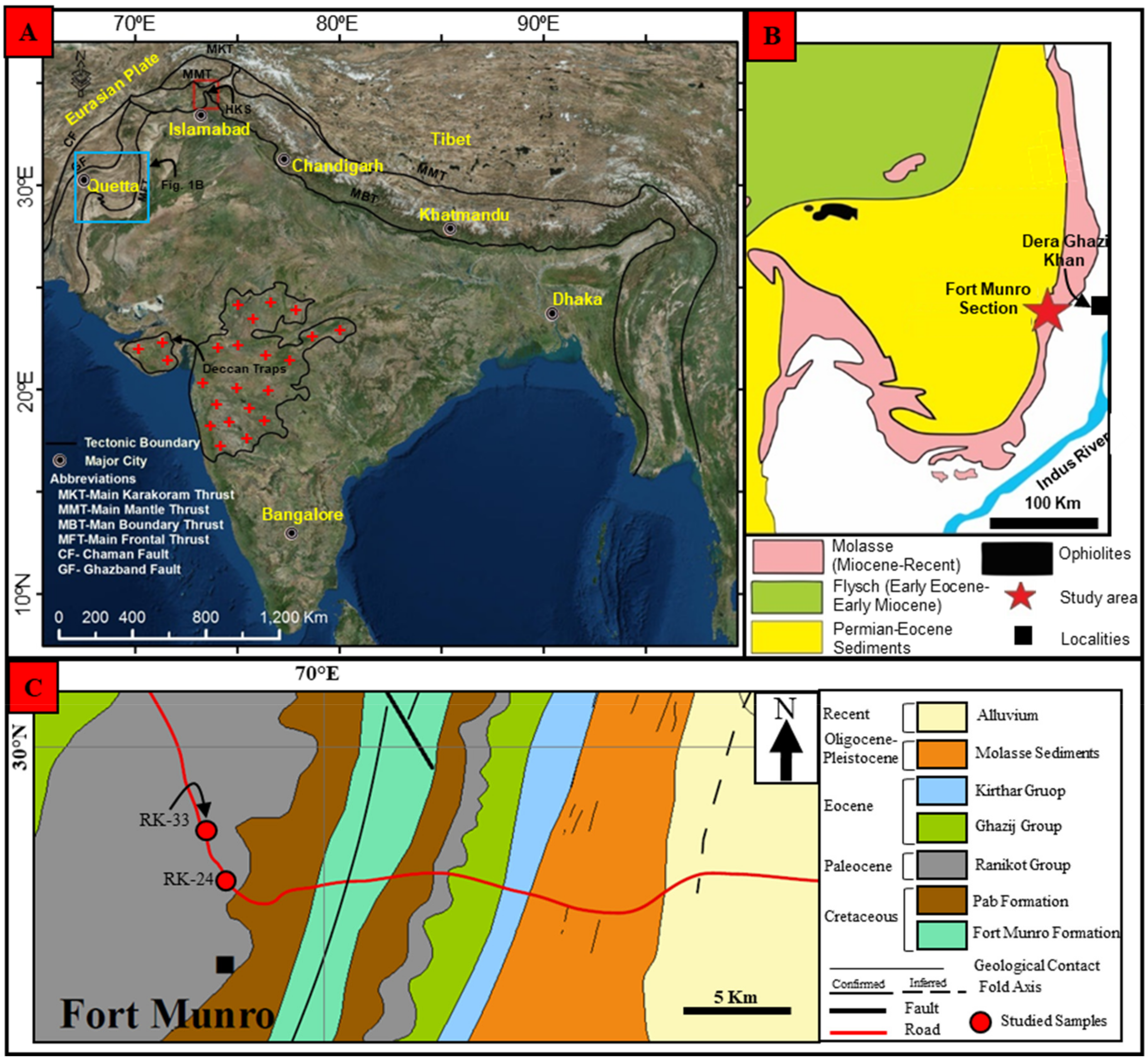
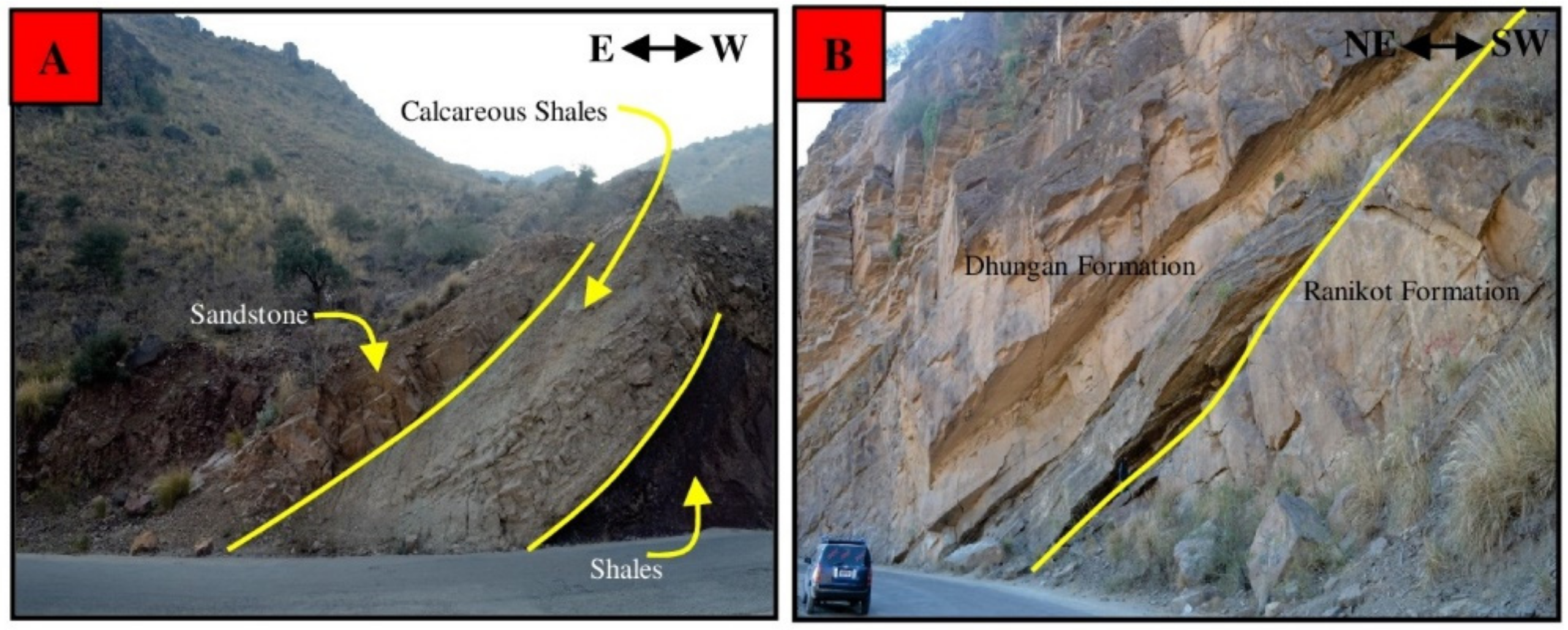
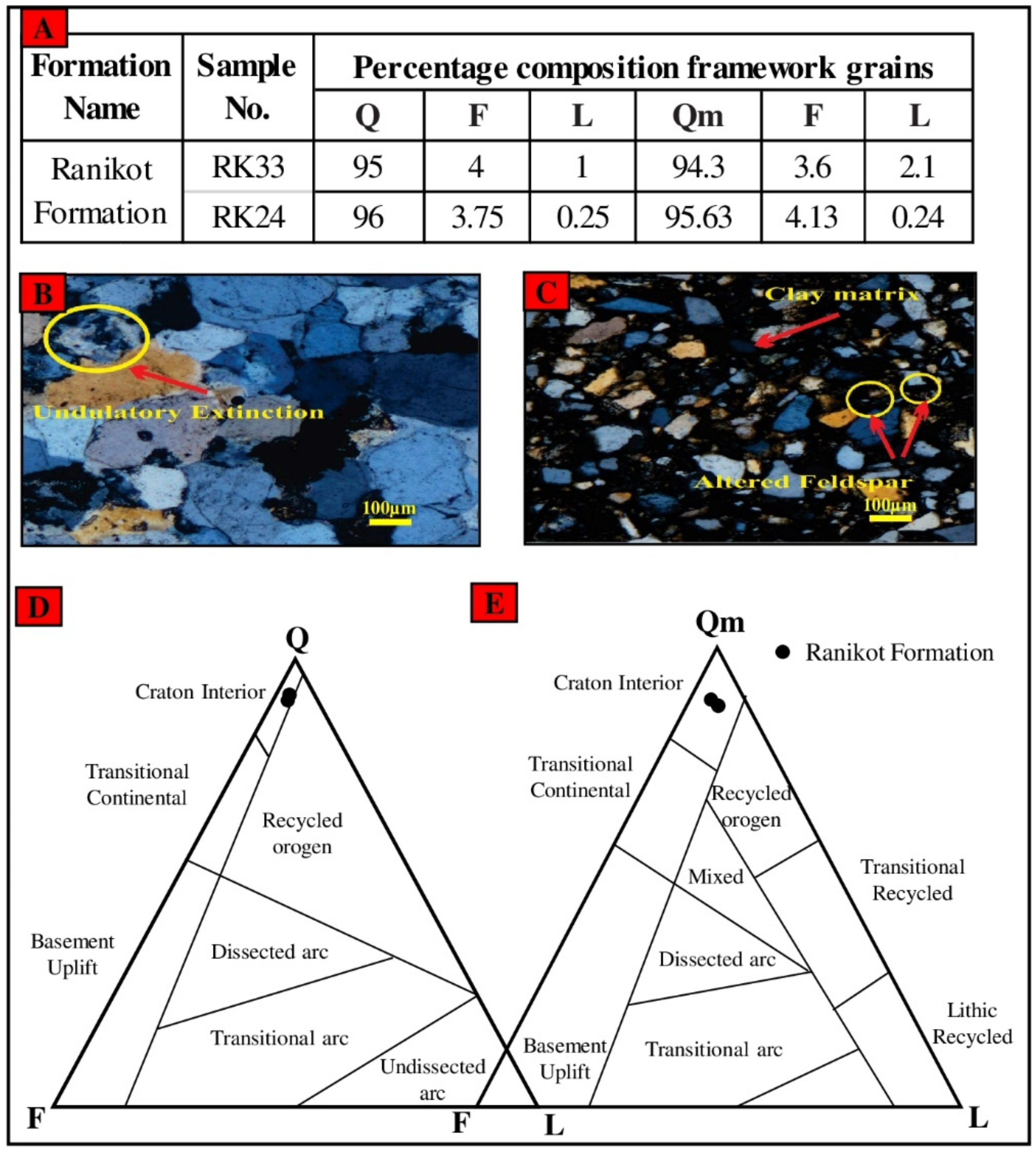
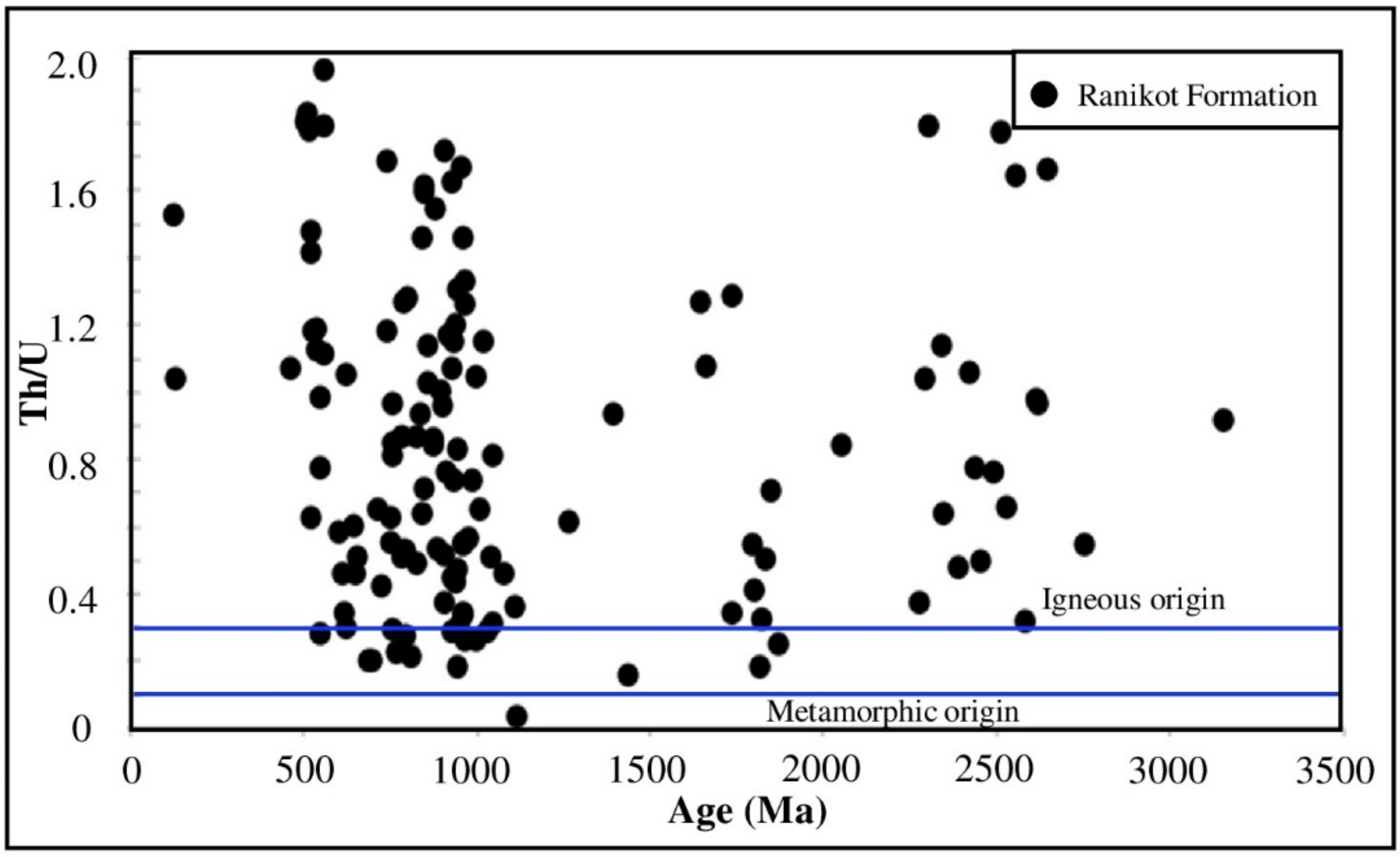
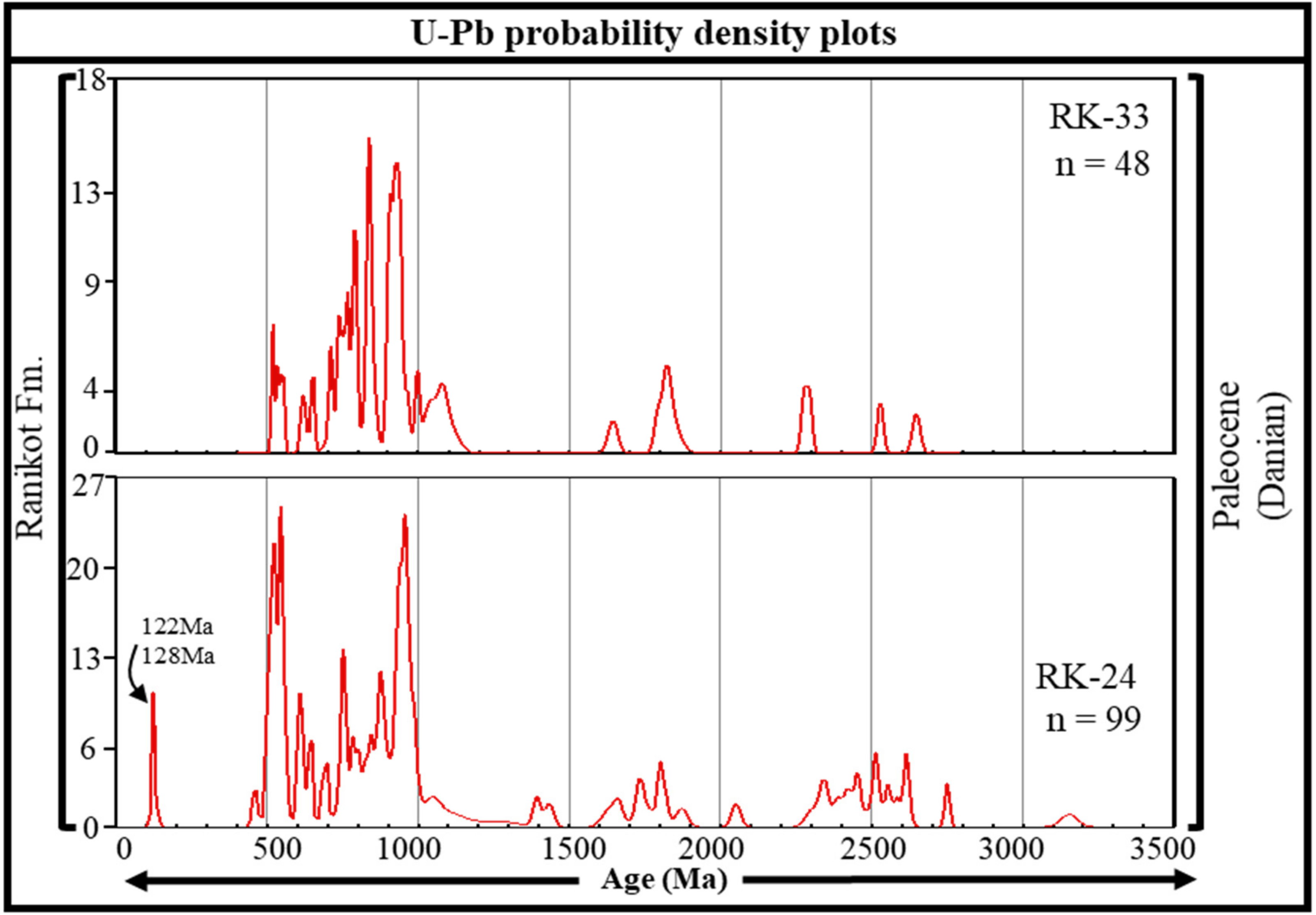
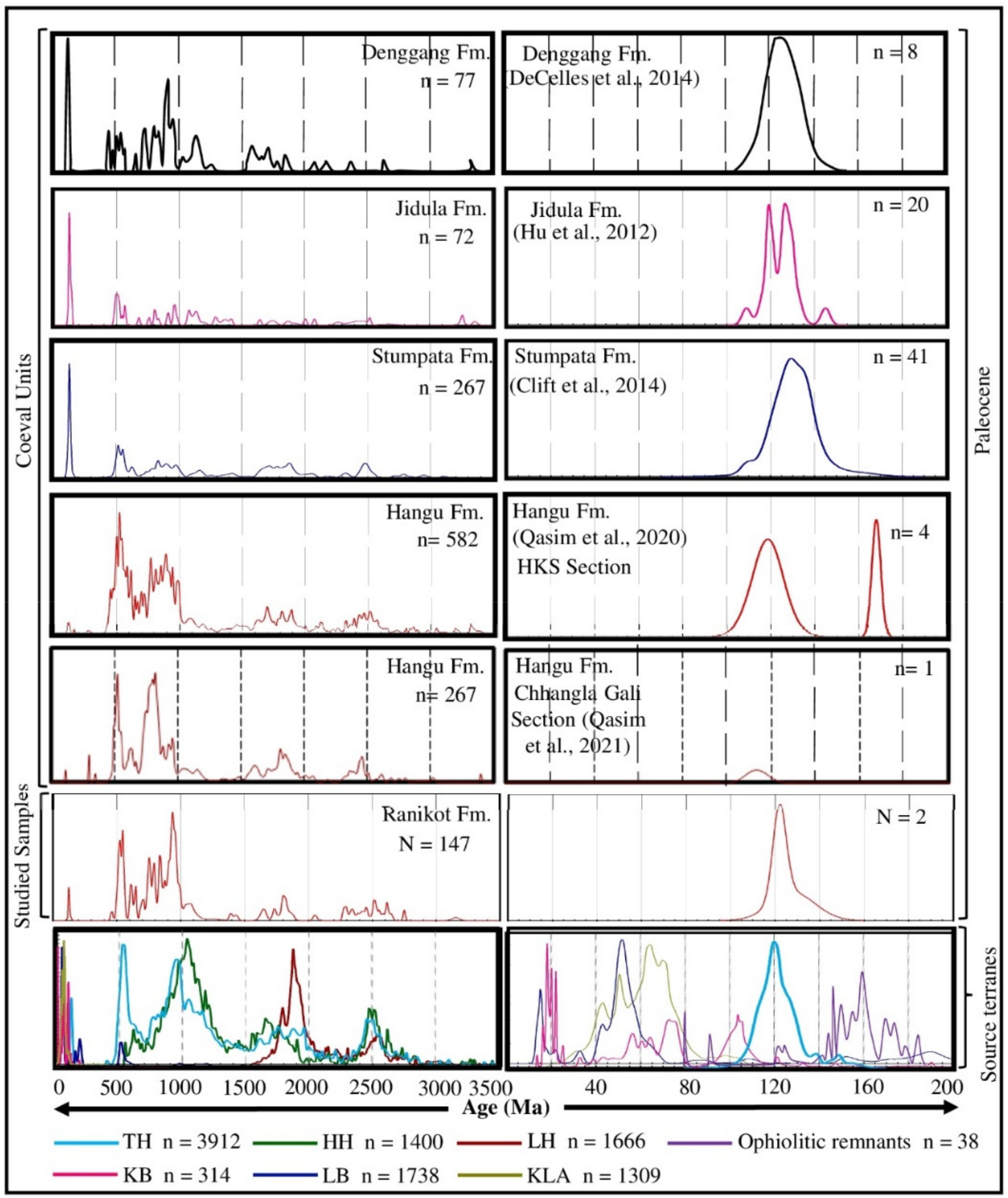
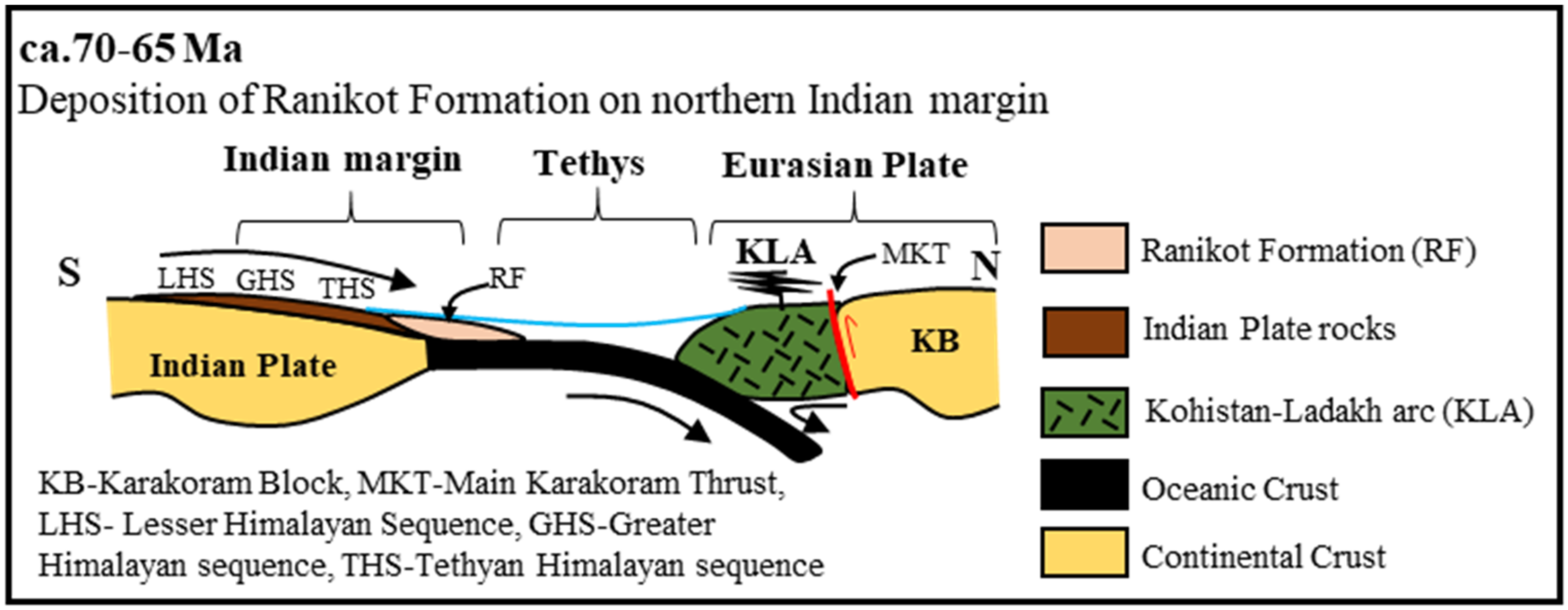
| Formation Name | Sample No. | Grain Shape | Fabric Support/Contacts | Sorting | Maturity | ||
|---|---|---|---|---|---|---|---|
| Roundness | Sphericity | Textural | Mineralogical | ||||
| Ranikot Formation | RK-33 | Sub angular-Sub rounded | Low | Grain supported, Pointed contacts | Moderately sorted | Mature | Mature |
| RK-24 | Sub rounded-rounded | Low-Medium | Grain supported, Pointed contacts | Moderately sorted | Mature | Mature | |
Disclaimer/Publisher’s Note: The statements, opinions and data contained in all publications are solely those of the individual author(s) and contributor(s) and not of MDPI and/or the editor(s). MDPI and/or the editor(s) disclaim responsibility for any injury to people or property resulting from any ideas, methods, instructions or products referred to in the content. |
© 2023 by the authors. Licensee MDPI, Basel, Switzerland. This article is an open access article distributed under the terms and conditions of the Creative Commons Attribution (CC BY) license (https://creativecommons.org/licenses/by/4.0/).
Share and Cite
Qasim, M.; Ashraf, J.; Ding, L.; Tanoli, J.I.; Khan, I.; Rehman, M.U.; Awais, M.; Ahmad, J.; Tayyab, O.; Jadoon, I.A.K. The Early Paleocene Ranikot Formation, Sulaiman Fold-Thrust Belt, Pakistan: Detrital Zircon Provenance and Tectonic Implications. Minerals 2023, 13, 413. https://doi.org/10.3390/min13030413
Qasim M, Ashraf J, Ding L, Tanoli JI, Khan I, Rehman MU, Awais M, Ahmad J, Tayyab O, Jadoon IAK. The Early Paleocene Ranikot Formation, Sulaiman Fold-Thrust Belt, Pakistan: Detrital Zircon Provenance and Tectonic Implications. Minerals. 2023; 13(3):413. https://doi.org/10.3390/min13030413
Chicago/Turabian StyleQasim, Muhammad, Junaid Ashraf, Lin Ding, Javed Iqbal Tanoli, Imran Khan, Mohib Ur Rehman, Muhammad Awais, Jalil Ahmad, Owais Tayyab, and Ishtiaq Ahmad Khan Jadoon. 2023. "The Early Paleocene Ranikot Formation, Sulaiman Fold-Thrust Belt, Pakistan: Detrital Zircon Provenance and Tectonic Implications" Minerals 13, no. 3: 413. https://doi.org/10.3390/min13030413
APA StyleQasim, M., Ashraf, J., Ding, L., Tanoli, J. I., Khan, I., Rehman, M. U., Awais, M., Ahmad, J., Tayyab, O., & Jadoon, I. A. K. (2023). The Early Paleocene Ranikot Formation, Sulaiman Fold-Thrust Belt, Pakistan: Detrital Zircon Provenance and Tectonic Implications. Minerals, 13(3), 413. https://doi.org/10.3390/min13030413






